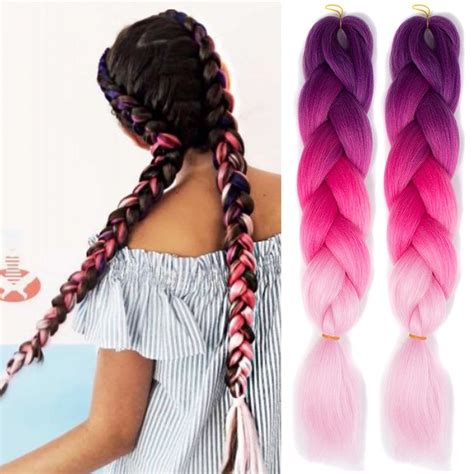The Allure of Synthetic Braids
Synthetic braid extensions have emerged as a popular choice for those seeking versatile and affordable hair transformations. Made from artificial materials, these braids offer a myriad of styles and colors, empowering you to experiment with different looks without committing to long-term treatments. With their low cost and easy maintenance, synthetic braids have become an essential tool in the hair styling arsenal.

Types of Synthetic Braid Extensions
The market offers a diverse range of synthetic braid extensions, each with its unique texture and appearance. Here are some of the most common types:
-
Kanekalon Braids: Known for their soft, silky feel and natural sheen, Kanekalon braids are a popular choice for box braids and other intricate styles.
-
Jumbo Braids: These thick, voluminous braids create a bold and dramatic look. They are often used in cornrows, Ghana braids, and Senegalese twists.
-
Yarn Braids: Made from acrylic yarn, these braids are lightweight and affordable, offering a playful touch to any style.
-
Distressed Braids: Pre-stretched and textured, these braids mimic the appearance of natural hair growth, resulting in a more relaxed and lived-in look.
Benefits of Synthetic Braid Extensions
-
Versatility: Braid extensions allow you to transform your style instantly, whether you desire a classic look or something more bohemian.
-
Affordability: Compared to human hair extensions, synthetic braids are significantly more affordable, making them a budget-friendly option.
-
Low Maintenance: Unlike human hair extensions, synthetic braids require minimal maintenance. They can be washed and dried without worrying about damage.
-
Durability: Synthetic braids are designed to withstand wear and tear, ensuring they maintain their shape and quality for an extended period.
Common Mistakes to Avoid
-
Overstretching: Avoid stretching the braids excessively, as this can cause them to lose their shape and unravel.
-
Too Tight: When braiding, ensure the braids are not pulled too tightly, as this can lead to discomfort and damage to your natural hair.
-
Neglecting Care: While synthetic braids require less maintenance than human hair extensions, they still need to be washed and conditioned regularly to prevent tangles and buildup.
-
Heat Damage: Avoid using heat styling tools on synthetic braids, as this can cause them to melt or become frizzy.
Step-by-Step Approach to Installing Synthetic Braid Extensions
Materials:
- Synthetic braid extensions
- Comb
- Hairbrush
- Hair clips
- Hair gel or mousse (optional)
Steps:
-
Prepare Your Hair: Wash and condition your natural hair. Braid it into small cornrows or sections.
-
Attach the Braids: Separate a small section of the synthetic braid and feed it through a hair loop at the base of a natural cornrow.
-
Wrap and Braid: Wrap the synthetic braid around the natural hair and begin braiding, ensuring the braids are even and tight.
-
Secure the End: Once the braid reaches the desired length, secure it with a bobby pin or rubber band.
-
Finish: Repeat steps 2-4 until all the desired braids are installed.
Tips and Tricks
-
Use a Small Amount of Hair Gel: Applying a small amount of hair gel or mousse to the natural hair before braiding can help improve hold and prevent slippage.
-
Section Your Hair: Sectioning your hair into smaller parts before braiding makes the process easier and more manageable.
-
Don’t Overtighten: Avoid pulling the braids too tightly, as this can cause discomfort and damage to your natural hair.
-
Use a Wide-Toothed Comb: Use a wide-toothed comb to gently detangle the braids and prevent breakage.
-
Sleep with a Silk Cap or Bonnet: To protect the braids from tangling and friction, sleep with a silk cap or bonnet.
Creative Applications of Synthetic Braid Extensions
-
Ombre Braids: Create a gradual color transition by using different shades of braid extensions, resulting in an ombré effect.
-
Goddess Locs: Braid extensions can be used to create faux goddess locs, giving you the bohemian and elegant look without the long commitment.
-
Micro Braid Bun: Use small, thin braids to create a chic and voluminous bun that will turn heads.
-
Braided Halo: Attach braid extensions to a wire or elastic band to create a braided halo, giving your hair a whimsical touch.
Market Statistics and Trends
According to the Hair Extensions Market Analysis 2023, the global synthetic hair extensions market is projected to reach $6.5 billion by 2030, growing at a CAGR of 5.2%. The increasing demand for affordable and versatile hair styling solutions is driving the growth of this market.
In North America, synthetic braid extensions have become a dominant force, with the United States and Canada accounting for over 60% of the market share. The rising popularity of protective hairstyles and the growing awareness of hair health are major influencers.
Conclusion
Synthetic braid extensions offer a wealth of possibilities for those seeking to transform their style without breaking the bank. Their versatility, affordability, and low maintenance make them an invaluable addition to any hair enthusiast’s tool kit. By understanding the different types, avoiding common mistakes, and embracing creative applications, you can harness the power of synthetic braid extensions to achieve endless hair transformations.
